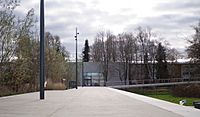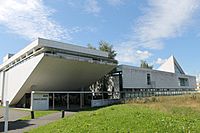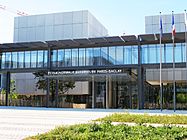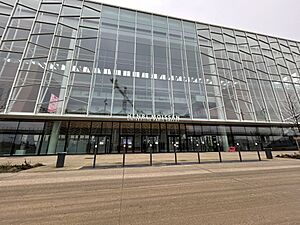Paris-Saclay University facts for kids
|
Université Paris-Saclay
|
|
 |
|
|
Former name
|
University of Paris Sud XI Paris Faculty of Sciences in Orsay |
|---|---|
| Type | Public research university |
| Established | c. 1150 University of Paris 1956 University of Paris in Orsay 1971 Paris-Sud University 2014 As a community 2019 Replaces Paris-Sud University |
| Affiliation | Chancellery of the Universities of Paris Udice Group |
| Chancellor | Bernard Beignier (Chancellor of the universities of Paris) |
| President | Prof. Camille GALAP |
|
Academic staff
|
10,500 |
| Students | 60,000 |
| Undergraduates | 5,400 |
| Postgraduates | 23,300 |
| 6,000 | |
| Location |
Orsay
,
,
France
48°42′42″N 2°10′17″E / 48.7117343°N 2.1712888°E |
| Campus | Midsize city, 200 hectares (490 acres) |
Paris-Saclay University (French: Université Paris-Saclay) is a large public university in Orsay, France. It is also a major center for scientific research. The university was created in 2019. It brought together several top technical schools, engineering schools, and research centers. Now, it has fifteen colleges and over 48,000 students.
The French government wanted Paris-Saclay to be as good as the best research universities in the world. It has more than 275 labs. These labs study many areas of physics, like tiny particles and outer space. They also work on electronics and nanoscience (the study of very small things).
Paris-Saclay is part of a bigger area called the Paris-Saclay cluster. This cluster is a hub for research and high-tech companies. It includes other universities and businesses. Many important discoveries in math have happened here.
The university has two main campuses. One is the "Plateau" campus in Orsay, Gif-sur-Yvette, and Palaiseau. The other is the older campus in the valley, near the Château de Launay. There are also other campuses for medicine and law in different towns.
As of 2021, many famous scientists have been connected to Paris-Saclay. This includes 11 Fields Medal winners (for math) and 4 Nobel Prize winners.
Contents
History
Paris-Saclay University took over from the University of Paris-Sud in 2019. The University of Paris-Sud started in 1971. Before that, it was part of the University of Paris, which began around 1150.
The idea for Paris-Saclay University started in 2015. The goal was to create a top-ranked university focused on research.
How it Started: 20th Century
Research Centers in Orsay
After World War II, the study of nuclear physics and chemistry grew quickly. This research needed powerful machines called accelerators, which took up a lot of space. So, the University of Paris and other schools looked for land south of Paris, near Orsay.
In the 1940s, two French physicists, Irène Joliot-Curie and Frédéric Joliot-Curie, thought about moving parts of the university outside Paris. In 1942, Irène Joliot-Curie found a good spot near Orsay.
In the 1950s, many important schools and research groups moved to the Saclay plateau. In 1954, France decided to build its own nuclear physics research center there.
In 1955, the University of Paris bought land in Orsay. Irène Joliot-Curie suggested creating the Orsay Institute of Nuclear Physics. Construction started that same year. She passed away in 1956, and Frédéric became the first director. A large particle accelerator was also built there.
More and more students were joining the University of Paris. The main campus, the Sorbonne, became too crowded. So, in 1958, some science classes moved to Orsay.
The University of Paris-Sud
In 1965, the science campus in Orsay became separate from the University of Paris. It was first called the Orsay Faculty of Sciences. Then, in 1971, it became a full university: the University of Paris-Sud (Paris XI). It grew to include medicine, law, economics, and pharmacy, becoming a diverse university.
Modern Times: 21st Century
Working Together: The Campus Paris-Saclay
In 2007, a group for research and higher education was formed in Orsay and Saclay. It included the University of Paris-Sud, the University of Versailles, and the École normale supérieure de Cachan (now ENS Paris-Saclay).
In 2008, these universities received funding from a French plan called Plan Campus. This led to a bigger idea: creating a single, large university called Université Paris-Saclay. The French Ministry of Higher Education supported this plan.
A special foundation was set up to bring together different schools and research centers. Many institutions planned to move to the Paris-Saclay area as it grew into a technology hub.
The University System Université Paris-Saclay
In 2014, the different schools agreed to form the Paris-Saclay University system. This allowed them to award degrees together. The goal was for this system to become a full university.
The first school year for this new system began in September 2015.
To become a top university, Paris-Saclay brought together some of France's best schools, called grandes écoles, with public universities. Each school kept some independence but shared many resources. This is similar to how universities like University of Oxford and Cambridge work. The aim was to be a top university in Europe and even worldwide.
There were some disagreements between the different schools and ministries. A report in 2017 pointed out problems like a lack of housing and transport. In 2017, the University of Paris-Sud suggested merging with the university system to create a single Paris-Saclay University.
In October 2017, French President Emmanuel Macron announced that the members would split into two university groups: Paris-Saclay University and the Polytechnic Institute of Paris.
On the same day, a new math school was opened in Orsay. It brought together math teams from Paris-Saclay University and the CNRS.
The Collegiate University
In January 2020, Paris-Saclay University officially replaced University of Paris-Sud. By 2025, the University of Versailles and the University of Evry will also join it. They will become "Paris-Saclay University in Versailles" and "Paris-Saclay University in Évry."
Since 2020, Paris-Saclay has done very well in global university rankings. It has been ranked 1st in the world for mathematics and 9th for physics.
In April 2022, the new Agro Paris-Saclay Campus opened in Palaiseau. It covers 4.2 hectares and hosts nearly 2,000 students. It also has 1,350 teachers, researchers, and staff from the AgroParisTech school.
On April 18, 2023, Paris-Saclay University opened France's largest research center for pharmaceuticals (medicines). It is called the Henri-Moissan Centre. It brings together the School of Pharmacy and chemistry and biology departments. Over 3,000 students and 1,000 staff have moved in since September 2022.
Since October 2023, the university has partnered with the IPSA school. They offer special double degrees in aerospace studies.
In February 2024, Paris-Saclay, with nearly 50,000 students, faced some leadership challenges. After several months, Camille Galap was elected as the new head of the university on June 11, 2024. He promised to help the university overcome its difficulties.
What the University Studies
Paris-Saclay University has five main departments: Sciences, Medicine, Pharmacy, Law-Economics-Management, and Sports Sciences. It also has an Engineering school and three technical institutes. There is also an undergraduate school for new students.
The university also includes four important grandes écoles: CentraleSupélec, AgroParisTech, ENS Paris-Saclay, and the Institut d'Optique Graduate School. Two other universities, Versailles Saint-Quentin-en-Yvelines University and University of Évry Val d'Essonne, are also connected.
It combines resources from many French universities and grandes écoles. It also works with various research groups.
Initially, other grandes écoles were part of this group. However, due to different ways of working, five of them created their own university, the Polytechnic Institute of Paris. Both Paris-Saclay and the Polytechnic Institute of Paris plan to work together on some master's degrees.
Faculties and Institutes
| Name | Foundation | Academic degree | Field | Students | Campus | Teaching language | ||
|---|---|---|---|---|---|---|---|---|
| Paris-Saclay Undergraduate University School (École Universitaire de Premier Cycle Paris-Saclay) | Orsay IUT | 1971 | 2019 | Undergraduate | Law, Economics, and Science | 13,000 | Paris-Saclay, Guyancourt, Sceaux, Cachan, Évry-Courcouronnes | French |
| Sceaux IUT | 1970 | |||||||
| Cachan IUT | 1971 | |||||||
| Paris-Saclay Faculty of Sciences | 1956 and 1971 | Double Licence diploma (a selective bachelor's degree) and postgraduate | Science | 10,000 | Paris-Saclay | French, English | ||
| Paris-Saclay Faculty of Law, Economics and Management | 1968 | Law and economics | 6,000 | Sceaux | ||||
| Paris-Saclay Faculty of Pharmacy | 1972 | Medicine | 3,500 | Paris-Saclay | ||||
| Paris-Saclay Medical School | 1971 | 3,400 | Le Kremlin-Bicêtre, Paris-Saclay | |||||
| Paris-Saclay Faculty of Sports Sciences | 1985 | Science | 1,500 | Paris-Saclay | ||||
| Polytech Paris-Saclay | 2004 | Engineering | 820 | Paris-Saclay | ||||
Grandes Écoles and Graduate Schools
| Name | Foundation | Field | Students | Campus | |
|---|---|---|---|---|---|
| Grandes Écoles | AgroParisTech | 1826 | Life sciences | 2,420 | Paris-Saclay |
| CentraleSupélec | 2015 | Science and Engineering | 5,350 | Paris-Saclay, Rennes, Metz | |
| ENS Paris-Saclay | 1892 | Science | 1,360 | Paris-Saclay | |
| Institut d'optique Graduate School | 1917 | Optics | 440 | Paris-Saclay | |
| Graduate schools | Paris-Saclay Graduate School of Law | 2019 | Law | Guyancourt, Sceaux | |
| Paris-Saclay Graduate School of Physics | 2019 | Physics | Paris-Saclay, Versailles, Évry-Courcouronnes | ||
| Paris-Saclay Graduate School of Economics and Management | 2019 | Economics | Guyancourt, Sceaux | ||
| Institute of Light Sciences | 2019 | Science | Paris-Saclay | ||
| Paris-Saclay Graduate School of Life Sciences and Health | 2019 | Life Sciences and Health | Paris-Saclay, Le Kremlin-Bicêtre | ||
| Paris-Saclay Graduate School of Mathematics | 2019 | Mathematics | Paris-Saclay | ||
| Paris-Saclay Graduate School of Sociology and Political science | 2019 | Politics and sociology | Guyancourt, Sceaux | ||
| Paris-Saclay Graduate School of Engineering and Systems science | 2019 | Science and engineering | Paris-Saclay | ||
| Paris-Saclay Graduate School of Computer Science | 2019 |
-
ENS Paris-Saclay
Associated Universities
| Name | Foundation | Academic degree | Field | Students | Campus |
|---|---|---|---|---|---|
| Versailles Saint-Quentin-en-Yvelines University | 1987 and 1991 | Undergraduate and postgraduate | Science, social science and life science | 19,000 | Versailles, Montigny-le-Bretonneux, Guyancourt |
| University of Évry Val d'Essonne | 1991 | Science, social science and life science | 10,500 | Évry-Courcouronnes |
Research Organizations
Many research groups have centers at Paris-Saclay University. These groups keep some independence but work closely with the university.
- CEA (Atomic Energy and Alternative Energies Commission)
- CNRS (French National Centre for Scientific Research)
- Inria (French Institute for Research in Computer Science and Automation)
- INSERM (French Institute of Health and Medical Research)
- Institut des Hautes Études Scientifiques (Institute of Advanced Scientific Studies)
- INRA (French National Institute for Agricultural Sciences)
- ONERA (National Board of Study and Aerospace Research)
- SOLEIL (a national synchrotron facility, which is like a giant microscope)
- Pascal Institute – University of Paris-Saclay
- Institute of Theoretical Physics
Campuses
Orsay
The Plateau Campus
The main Paris-Saclay campus covers 495 acres (200 hectares). It is on the Saclay Plateau in Orsay, about 20 km south of Paris. This area is called the Quartier de Moulon. It also extends into Gif-sur-Yvette and Palaiseau. This campus has new buildings for Pharmacy, Chemistry, Biology, and Physics. It also has the main library, the École normale supérieure, and the CentraleSupélec engineering school.
Nearby, in Palaiseau, are the main buildings of AgroParisTech. This is the university's Institute of Life Sciences. The university's Center for Nanosciences and Nanotechnologies (C2N) is also here.
The Valley Campus
The university also has a historic campus south of the Bois de la Guyonnerie, in the Valley. It is close to Orsay's city center and the RER train station. This campus is centered around the Château de Launay. It holds other departments of the Faculty of Sciences and science libraries.
Other Campuses
Sceaux Campus
The J. Monnet Law School is on a 4.5-acre campus in Sceaux. This town is 6 kilometers south of Paris. It used to be the Sceaux Center for Legal Studies of the University of Paris, which opened in 1968. Nearby is the IUT of Sceaux. This professional school offers hands-on bachelor's programs.
Bicêtre Campus
The Faculty of Medicine is located at the Bicêtre University Hospital. It is very close to the Hôpital Bicêtre metro station. It has old buildings and a new 8,000 square meter building for research.
What You Can Study
Each school at Paris-Saclay University focuses on a specific scientific area. Students can use resources from other schools depending on their study program.
The main areas of study at Paris-Saclay University are:
- Biodiversity, Agriculture, Food, Society, Environment
- Biology, Medicine, Pharmaceutical studies
- Law, Political Science
- Humanities (like history and languages)
- Engineering, Sciences, and Information Technologies
- Sport and Human Motion Sciences
- Basic Sciences (like math and physics)
- Social Sciences (like sociology)
The academic programs follow a model similar to American and British universities:
- Paris-Saclay Undergraduate School – This is for bachelor's degrees. It is provided by Paris-Saclay faculties and two public universities: Versailles-Saint-Quentin University and University of Évry Val-d'Essonne.
- Paris-Saclay Graduate Schools – These offer master's degrees. There are 49 different master's programs, taught in both French and English.
- Paris-Saclay Research or Doctoral Schools – These are for PhD programs. There are 20 doctoral schools. PhD degrees earned after September 30, 2015, are given under the name "Paris-Saclay University."
Research Programs
Paris-Saclay University has over 300 research groups. They are organized into 10 doctoral schools, focusing on different fields:
- Chemistry
- Electrical engineering, optics, and electronics
- Mathematics
- Mechanics, energy, and physical processes
- Subatomic physics and astrophysics
- Wave and matter physics
- Planetary science and cosmology
- Life sciences
- Human and social sciences
- Information and communication sciences and technologies
University Rankings
| University rankings | |
|---|---|
| Global – Overall | |
| ARWU World | 12 (2024) |
| CWUR World | 32 (2023) |
| CWTS World | 123 (2023) |
| QS World | 73 (2025) |
| THE World | 58 (2024) |
| USNWR Global | 60 (2023) |
| National – Overall | |
| ARWU National | 1 (2024) |
| CWTS National | 3 (2023) |
| CWUR National | 2 (2023) |
| QS National | 4 (2025) |
| THE National | 2 (2024) |
| USNWR National | 3 (2023) |
The university is very well-known for Mathematics, Physics, and Computer Science. It ranks 1st in France for these subjects in many global rankings. These include the QS World University Rankings, Times Higher Education World University Rankings, and Academic Ranking of World Universities.
It is also connected to two of France's top engineering schools: École polytechnique and CentraleSupélec.
In August 2024, Paris-Saclay University was ranked 12th in the world by the Shanghai Ranking. It was also ranked 2nd worldwide for Mathematics and 3rd worldwide for Physics (1st in Europe).
Famous People: Nobel and Fields Winners
Paris-Saclay University was formed by combining several older universities and research institutes. So, the list below includes famous people from those older institutions who are now part of Paris-Saclay's history.
Nobel Prize Winners
- 2022: Alain Aspect – Studied and taught at ENS Paris-Saclay, IOGS, and Paris-Sud University. Won the Nobel Prize in Physics.
- 2007: Albert Fert – Professor at Paris-Sud University. Won the Nobel Prize in Physics.
- 1991: Pierre-Gilles de Gennes – Professor at CEA and Paris-Sud University. Won the Nobel Prize in Physics.
- 1935: Irène Joliot-Curie and Frédéric Joliot-Curie – They helped start the Orsay Faculty of Sciences. Won the Nobel Prize in Chemistry.
Fields Medal Winners (for Mathematics)
- 2022: Hugo Duminil-Copin – Studied and taught at IHES.
- 2010: Cédric Villani – Professor at IHES.
- 2010: Ngô Bảo Châu – Studied and taught at Paris-Sud University.
- 2006: Wendelin Werner – Professor at Paris-Sud University.
- 2002: Laurent Lafforgue – Studied and taught at Paris-Sud University, IHES.
- 1998: Maxim Kontsevich – Professor at IHES.
- 1994: Jean-Christophe Yoccoz – Studied and taught at Paris-Sud University.
- 1994: Jean Bourgain – Professor at IHES.
- 1982: Alain Connes – Professor at IHES.
- 1978: Pierre Deligne – Studied and taught at Paris-Sud University.
- 1966: Alexandre Grothendieck – Professor at IHES.
- 1958: René Thom – Professor at IHES.
See also
 In Spanish: Universidad Paris-Saclay para niños
In Spanish: Universidad Paris-Saclay para niños
- List of medieval universities
- List of public universities in France by academy
- Campus of the Paris-Saclay University
- Paris-Saclay Medical School
- Polytechnic Institute of Paris















